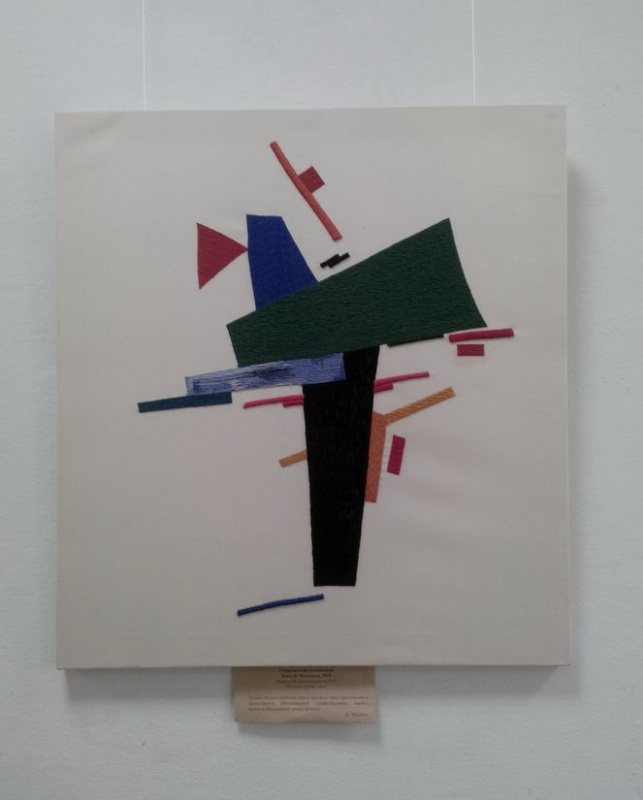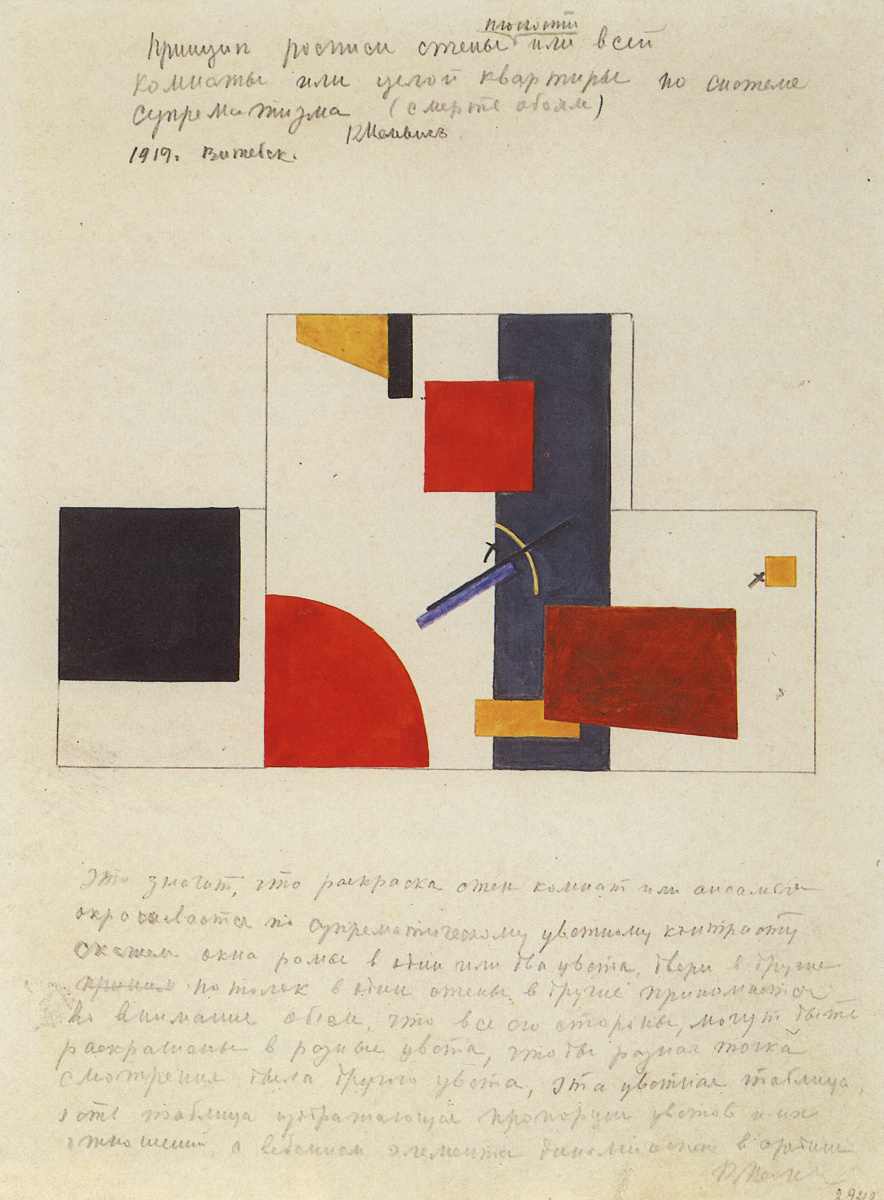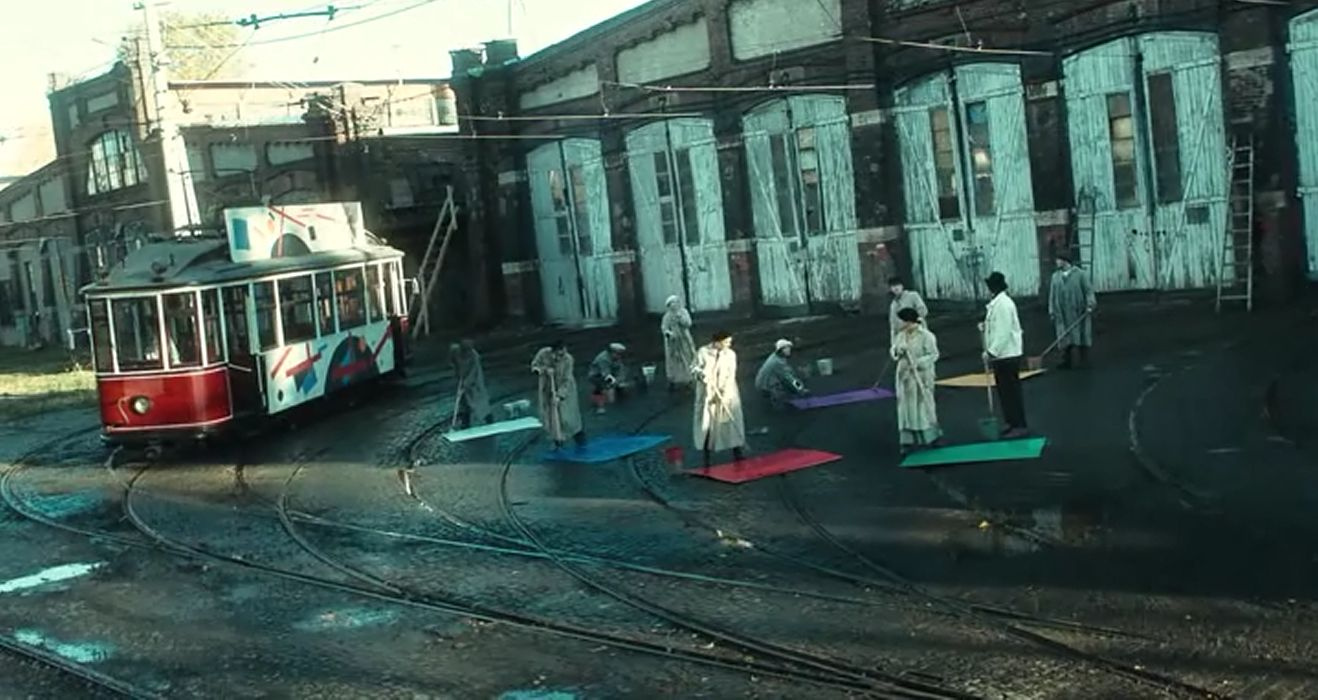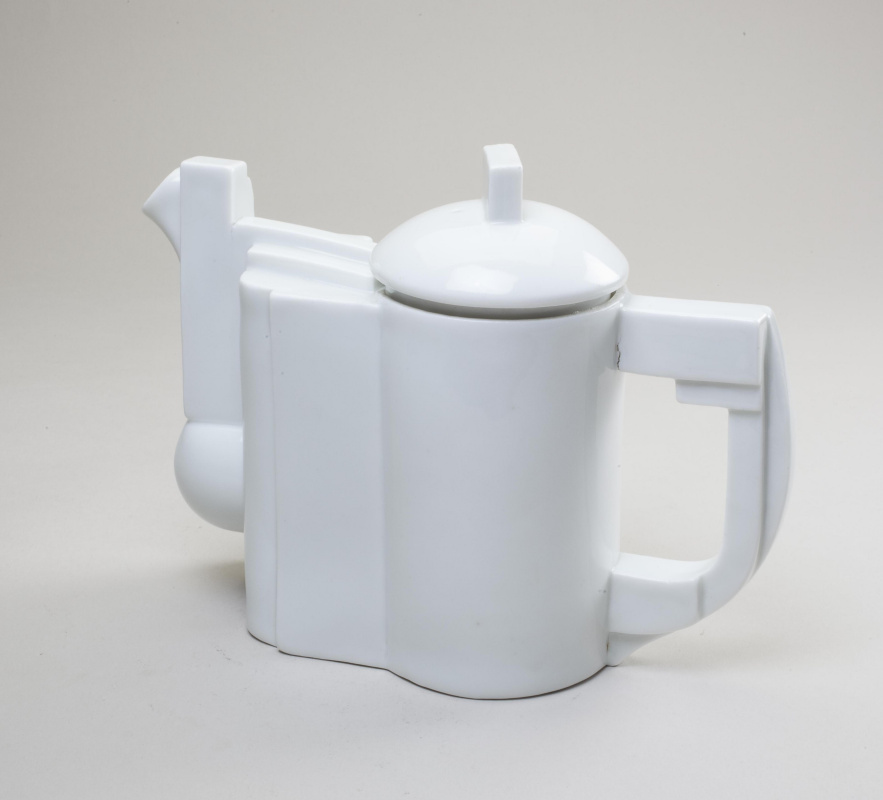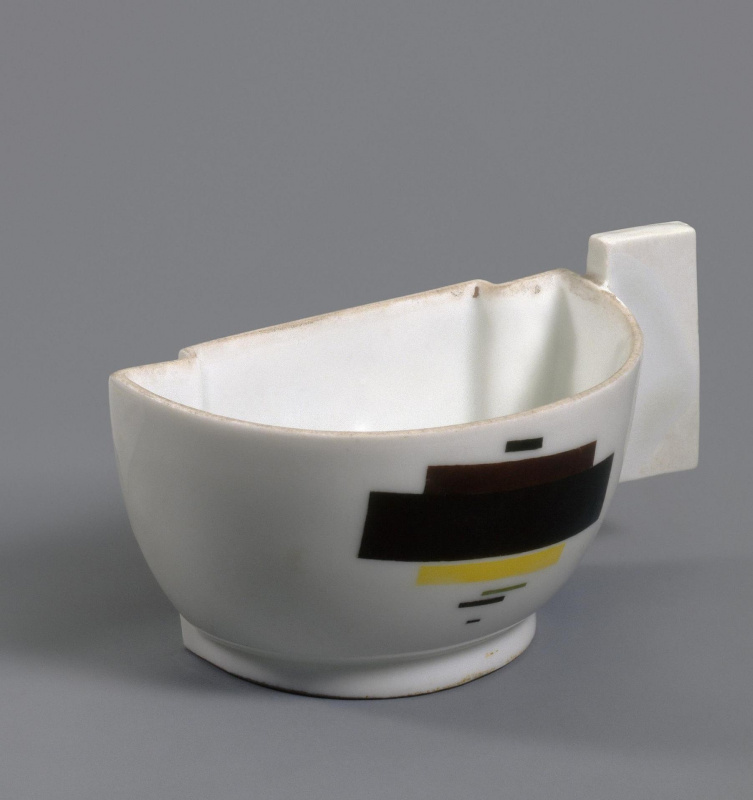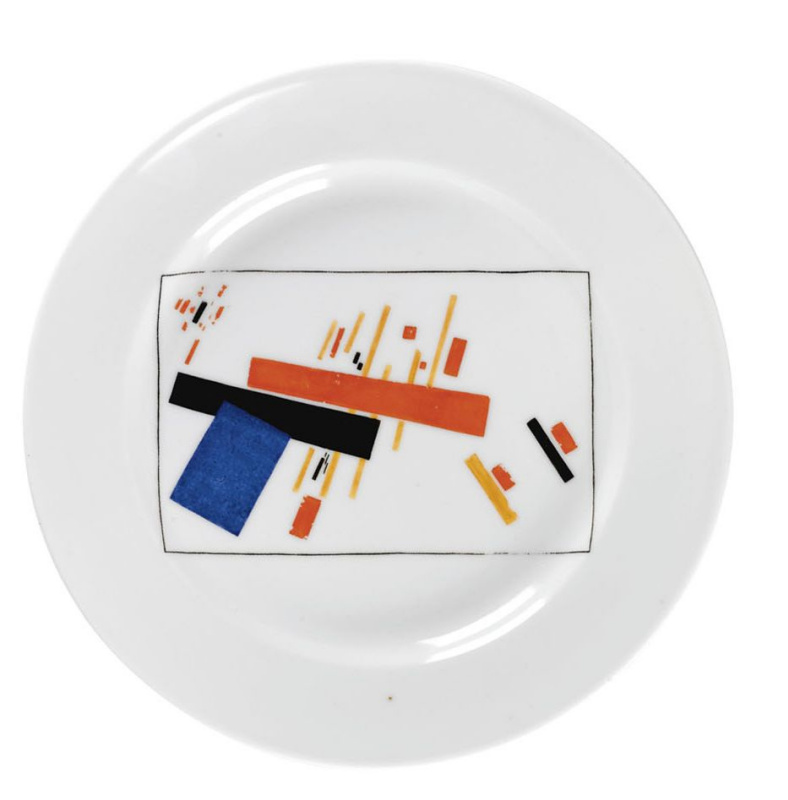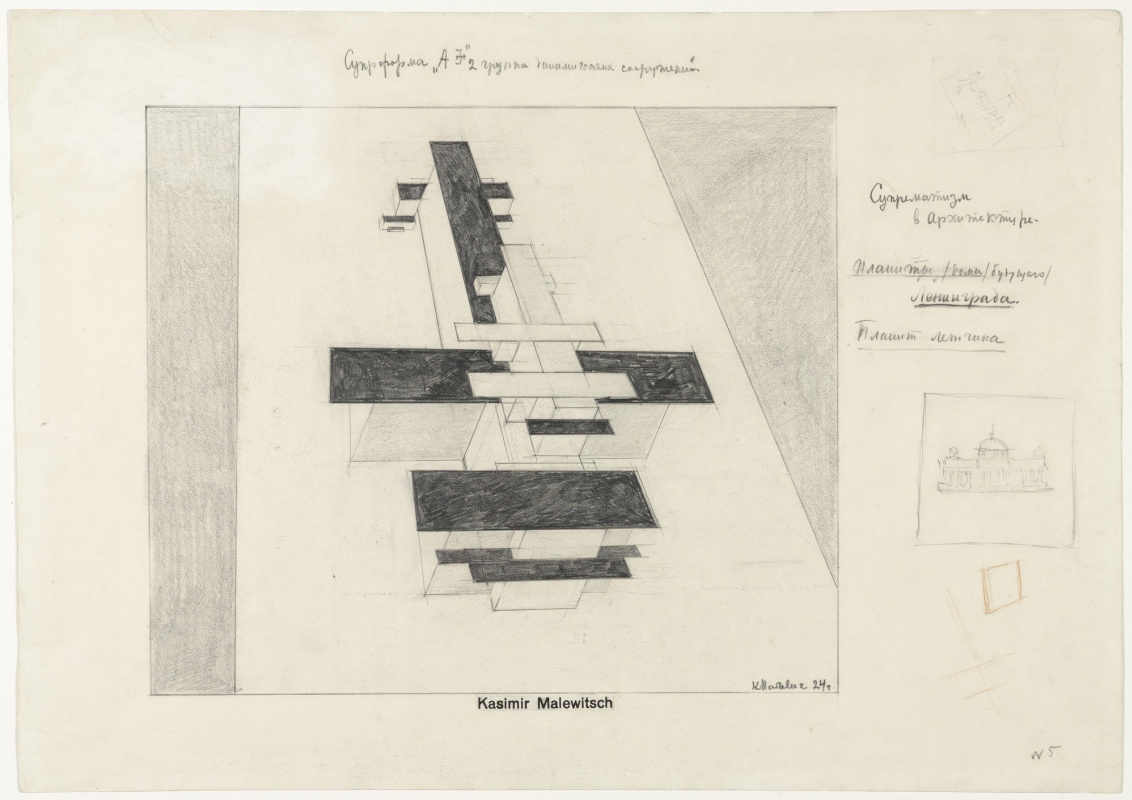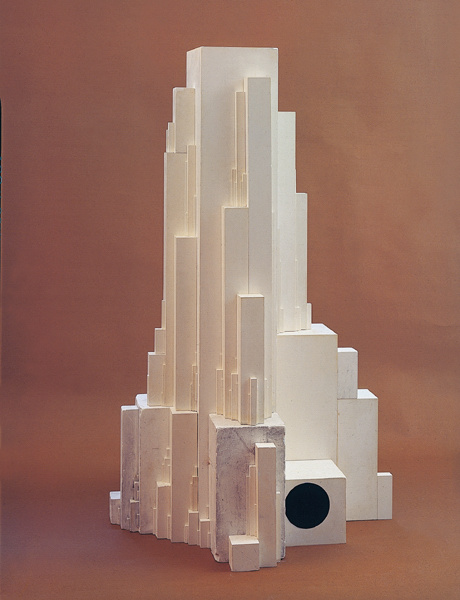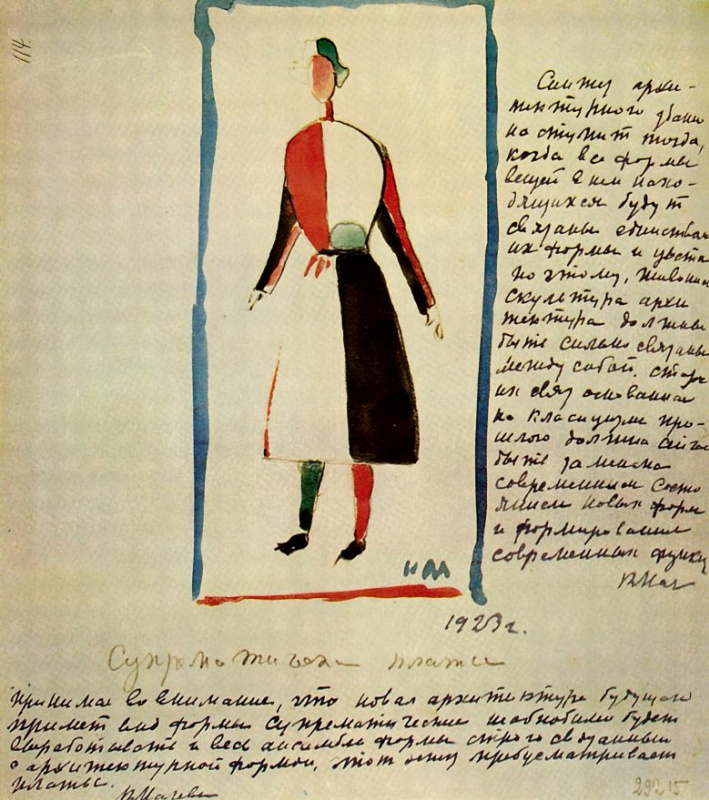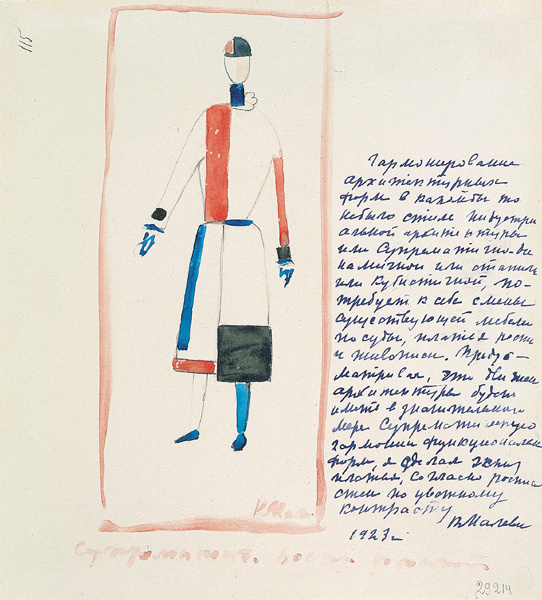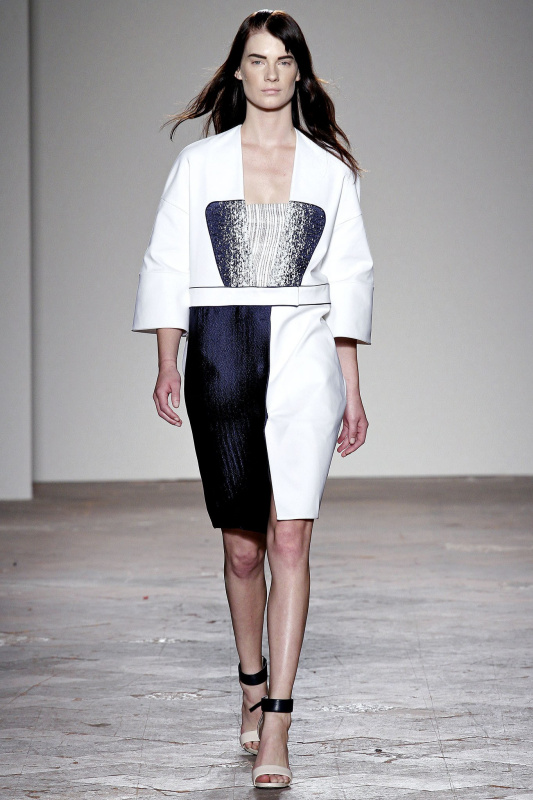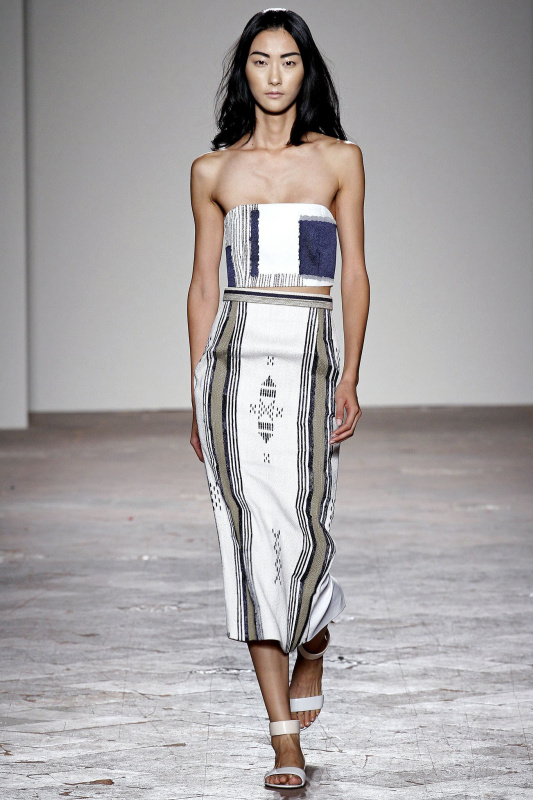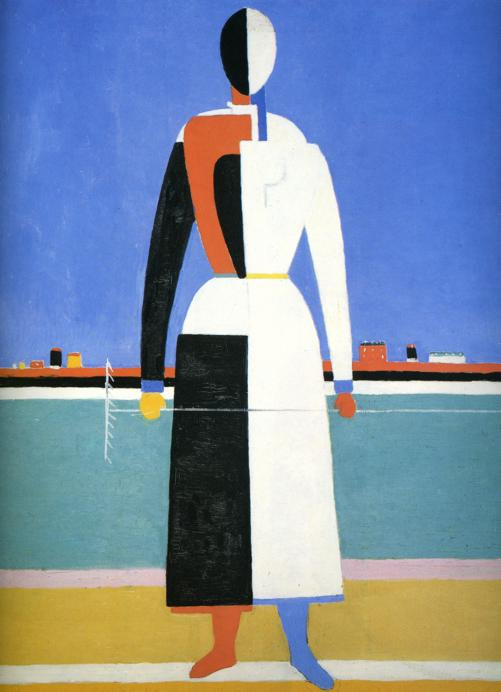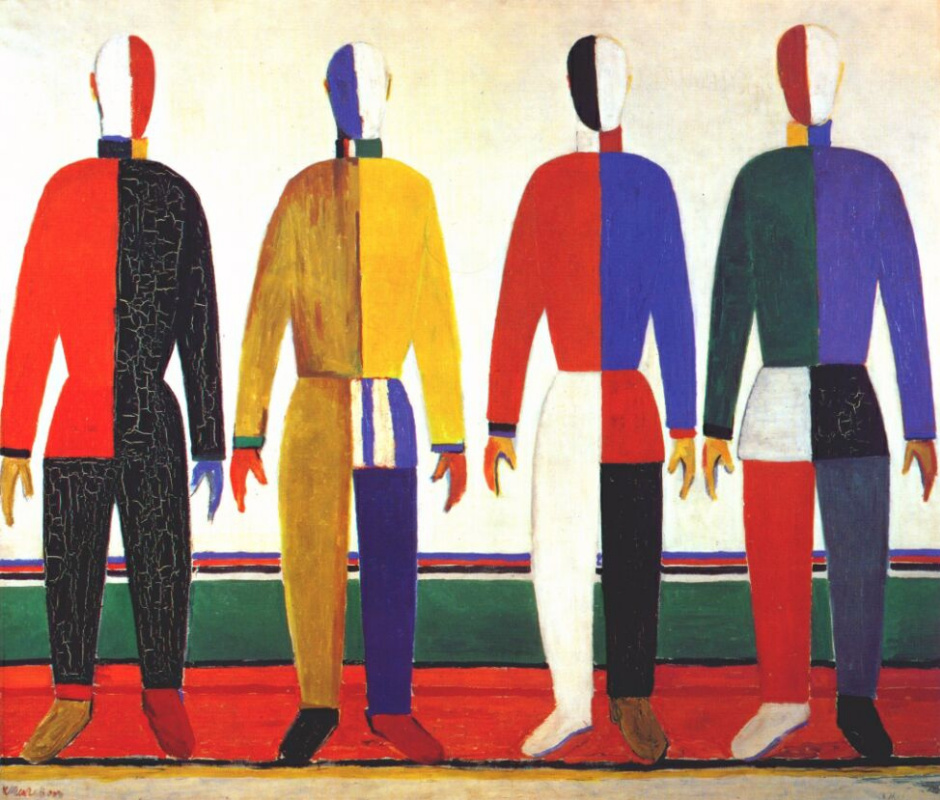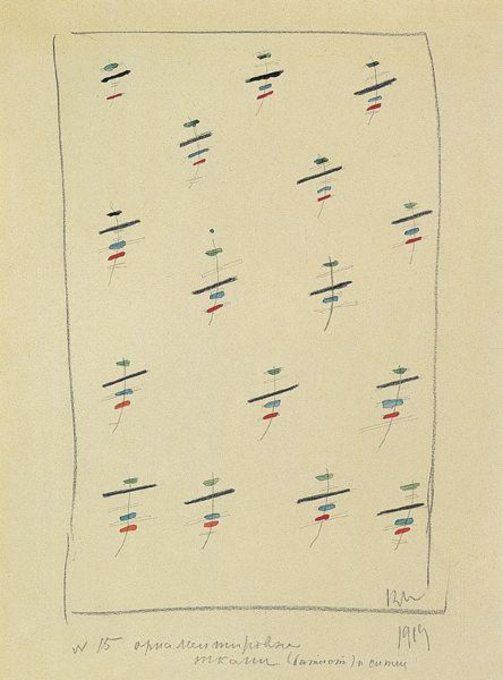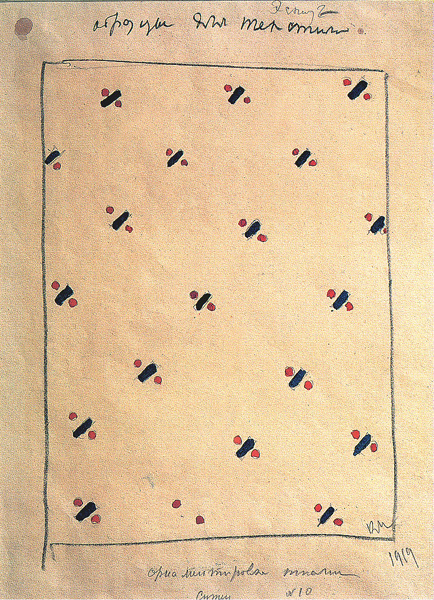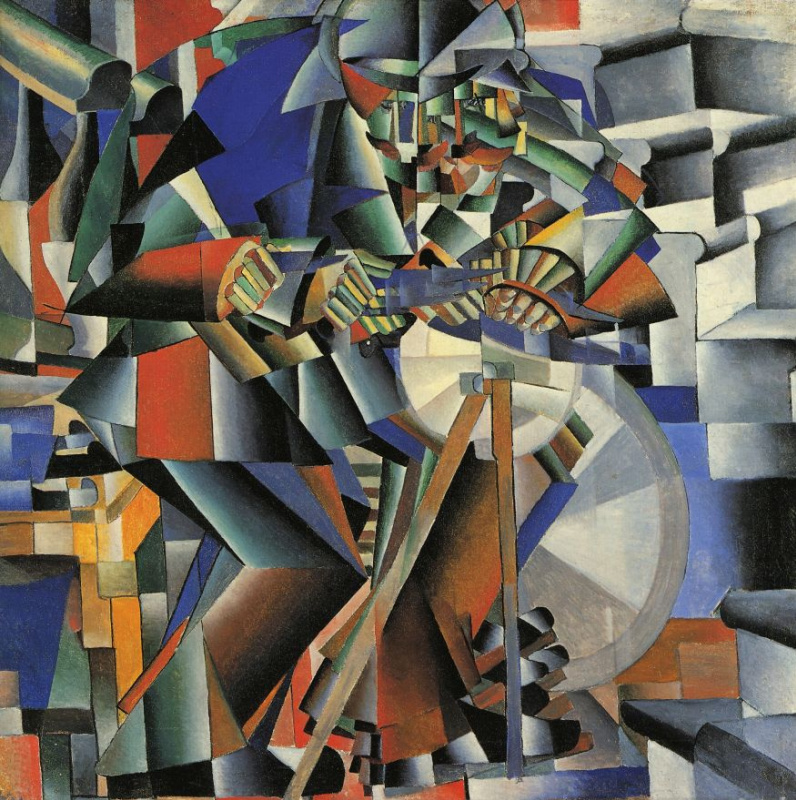Overalls, trams, pillow-cases, and famous faceted glass. Being a tireless singer of objectlessness, Malevich had a hand in designing absolutely earthly and tangible things.
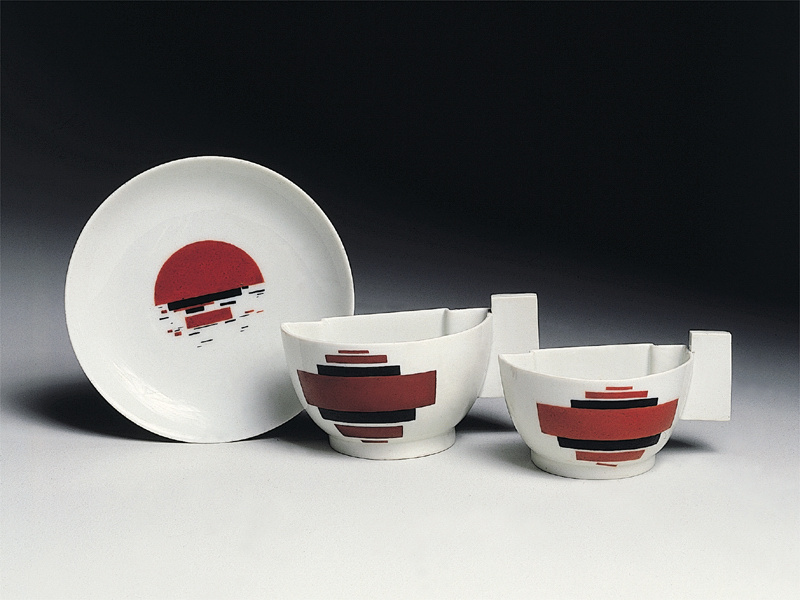
Creating a picture, Kazimir Malevich did not care about anyone experiencing an aesthetic pleasure from it. Introducing his ideas into architecture, he did not worry about whether the earthlings would feel good in the houses of the future. His art was intended to organize, discipline life, not to make it convenient, easy or beautiful.
However, no matter how Malevich tried to rise above the needs of "merchants and busy housewives", no matter how he tried to abandon "all the commotion of everyday life", the objective, earthly and digestable invariably took its toll. And the quite cosmic insights of Kazimir Severinovich turned out to be on Viciebsk trams, on Leningrad porcelain, and even on overalls, for example, of Moscow road workers now and then.
However, no matter how Malevich tried to rise above the needs of "merchants and busy housewives", no matter how he tried to abandon "all the commotion of everyday life", the objective, earthly and digestable invariably took its toll. And the quite cosmic insights of Kazimir Severinovich turned out to be on Viciebsk trams, on Leningrad porcelain, and even on overalls, for example, of Moscow road workers now and then.
Sketches for the Verbivka Village Folk Centre
The Verbivka Village Folk Centre (founded in 1900 in the Ukrainian village of Verbivka by the landowner Natalia Davydova) was famous for its embroidery. The handicrafts of the Folk Centre were successful not only among the Kyiv intelligentsia. One of the peasant women embroidered for Davydova even had a Gold Medal awarded to her at the International Exhibition in London. At first, folk motives prevailed in the Verbivka ornaments. But in 1915, Davydova and the artistic director of Verbivka, Alexandra Exter met Malevich in Moscow. In the same year, the Contemporary Decorative Art of the South of Russia exhibition presented three works made by his sketches. At the next exhibition in 1917, there were about 400 Suprematist embroideries: pillows, tablecloths, fans, screens, towels, bags and pillowcases — they all were "inspired by Malevich". Perhaps, if not for the revolution, Suprematism would have become the main fashionable trend of that time. It would become the basis for the design of clothes, furniture, interiors, it would make Kazimir Severinovich a millionaire. But times were difficult, Davydova was soon arrested; later, she emigrated and worked for Coco Chanel for some time. Malevich continued to praise and create non-objective art. Anyway, so it seemed to him.In the photo below
— embroidered Suprematist compositions by Kazimir Malevich (reconstruction by the craftsmen of the Institute of Decorative and Applied Arts, Kyiv). Source: mediaport.ua
— a still from Andrey Sarabyanov’s lecture, The Birth and Death of Suprematism. Source: arzamas. academy
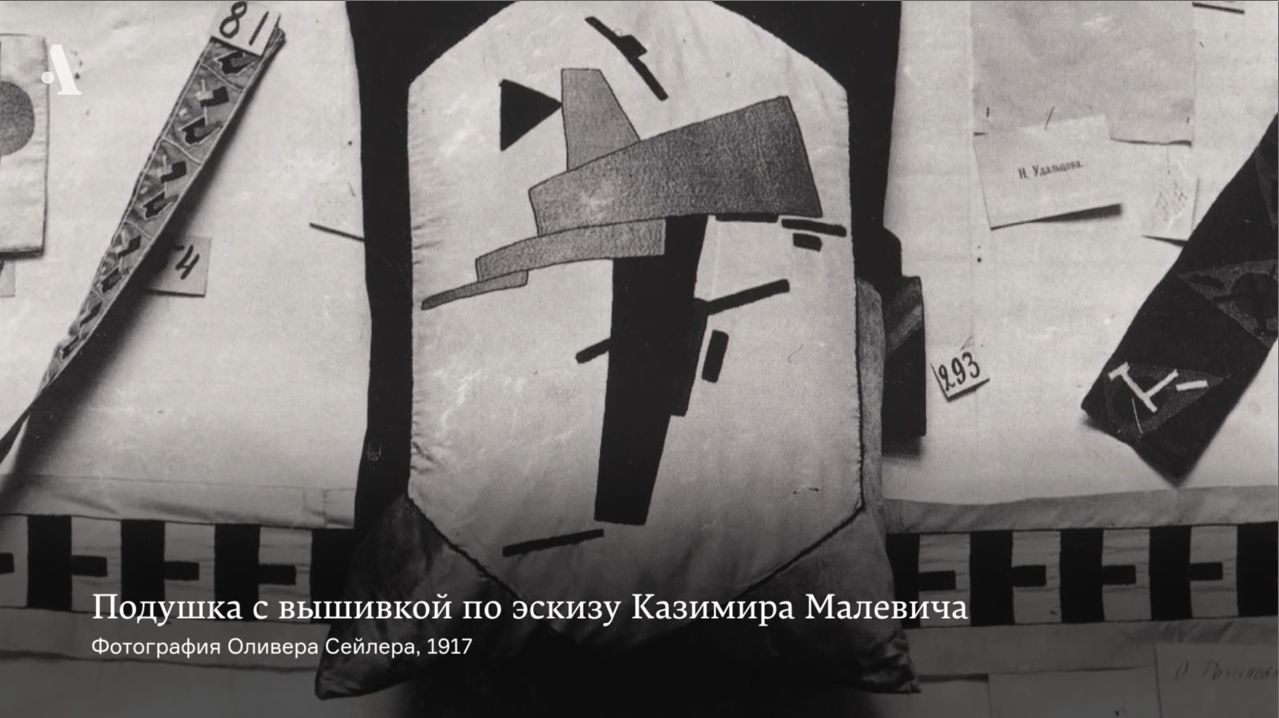
Pillow from the sketch
by Kazimir Malevich. Photo by Oliver Sailer. 1917
Viciebsk “graffiti”
In 1919, Kazimir Malevich went to Viciebsk to teach at the People’s Art School (headed by Marc Chagall). Here he founded UNOVIS, Utverditeli Novovo Iskusstva, The Champions of the New Art. The school tradition of decorating the city on the occasion of the holidays existed even before Malevich. But in the early 1920s, all Viciebsk celebrations acquired a distinctly Suprematic character. The rosy, active, ubiquitous members of UNOVIS, armed with paints and brushes, went to the streets, and there was absolutely no escape from them. Probably, Malevich’s contemporaries did not consider what was happening in Viciebsk strange. However, from the 21st century, the picture seems completely surreal. The façades of houses, city transport, tribunes, from which Soviet leaders and agitators spoke, everything resembled an interior of some fashionable New York gallery or a home of a modern billionaire here. Sergei Eisenstein, who visited Viciebsk in 1920, wrote: "Here, the main streets are covered with white paint on red bricks. Green circles scattered across the white background. Orange squares. Blue rectangles. This is Viciebsk in 1920. The brush of Kazimir Malevich went over its brick walls." Eisenstein’s words are confirmed by the Art Workers Day newspaper: "An Art Workers Union car, a propaganda tram or a propaganda carriage rushes into the street, into the thick of life, into the Polotsk market, into Svoboda Square, and the surprised people listen to serious music, songs about the black and red squares…"This endless Suprematist Mass annoyed Marc Chagall; not without reason he believed that UNOVIS resembled a sect more and more every day. However, the fact that he left Viciebsk shortly after Malevich’s arrival had another reason: Chagall seemed to not recognize his hometown any more.

A painting made according to Malevich’s sketch in 2014. Viciebsk, the house at the intersection of Lenina and Praŭdy streets. Photo source: evitebsk.com
Kazimir Malevich (actor Anatoly Bely), Suprematist tram and Suprematist street of Viciebsk in Alexander Mitta’s feature film, Chagall — Malevich (2013):
Overalls
Experimenting with colour, Malevich happened to go far beyond the canvas. The well-known art critic Paola Volkova described, for example, how he seated typists in spaces surronded by walls of a certain colour. And he studied how this or that colour affected their performance, mood, well-being. Malevich made predictions (Elena Petrovna will start coughing in 20 minutes, Olga Karlovna will type twice as fast, etc.) and tested them with practice. In the course of these experiments, he came to interesting conclusions. For example, he found out that the white colour increases pain and offered the now famous turquoise surgical gown. It was then that he had the idea of an orange high-visibility vest, the workwear that unmistakably identifies road workers today.Proven by experiments — a red-faced carpenter often sways when walking.
(Kazimir Malevich. Carpenter, 1927)
Leningrad porcelain
In 1922, the management of the Leningrad Porcelain Factory invited Kazimir Malevich and two of his students, Nikolai Suetin and Ilya Chashnik, to cooperate. Malevich, who previously snootishly declared that he had achieved "the zero of form" in his Black Square, was interested in volumetric forms at that time. He founded a form laboratory at the factory, where he created his famous "half cups" and the teapot, an outstanding example of the victory of design over functionality and convenience. Malevich left his apostles to paint the dishes: at the Porcelain Factory, Chashnik and Suetin created many ideologically driven (and at the same time extremely Suprematist) inkpots, vases and dinnerware sets with names like Tractor or Bread, and in 1932, Suetin even became artistic director of the factory.How did Malevich feel about the fact that his proud self-sufficient non-objectiveness served the Soviet ideology and, even more terrible, the "busy housewives"? Most likely, he watched the events with curiosity. While in Germany in 1927, Malevich told the Germans how he once cut a cup in half "just for artistic fun". At first, his wife was very angry, but soon she got used to scooping flour from the sack with the half-cup. Therefore, it is a toss-up who was forced to accept a compromise to a greater extent, Malevich or Soviet housewives.
Architectons
In 1923, Kazimir Malevich began to create architectons and planits. Architectons are plaster models, reminiscent of today’s skyscrapers (though lacking minor details like windows or doors). Planits are blueprints of houses in which, according to Kazimir Severinovich’s plan, earthlings, people of the future, could or rather were supposed to live. The architectons were completely non-objective compositions and were conceived as a universal principle for a "unified system of the world architecture of the Earth", whereas in his planits, Malevich condescended to functional nuances, such as floors, façades, steps. "Earthling can be everywhere on the top and inside the house… Each of its floors is quite low, you can walk on it or descend like on a staircase," he described the drawings. Of course, it does not mean that Malevich was concerned about the convenience of the earthlings. He just organized the space, as usual, and the earthling could only adapt. "If a crow settles in a tree or builds a nest in a tree, or a hoopoe builds a nest in a hollow, it does not mean that this tree has grown for this purpose, and the hoopoe will think of this tree as a tree with a specific practical task," Malevich explained.One way or another, the architectons and planites, albeit adjusted for the food needs of the earthlings, had a powerful influence on modern architecture.
Suprematist fashion
"Harmonization of architectural forms in any style of industrial architecture <…> will require new furniture, dishes, dresses…" said Malevich and sketched Suprematist chintz and dresses. Sweaters and scarves with Suprematist designs knitted by Malevich’s mother warmed the soul of progressive youth.However, Malevich didn’t have to create separate fashion sketches. Till this day, designers draw inspiration directly from his canvases. Here are some examples from the show of Italian Gabriele Colangelo for the spring-summer 2013 season. Please note that the fashion designer borrowed from Malevich not only the technique of working with colour, but also the shape, the rounded shoulder line. (Photo source: vogue.com)
It would not be surprising to find bedsheets with drawings invented by Malevich in some modern Ikea:
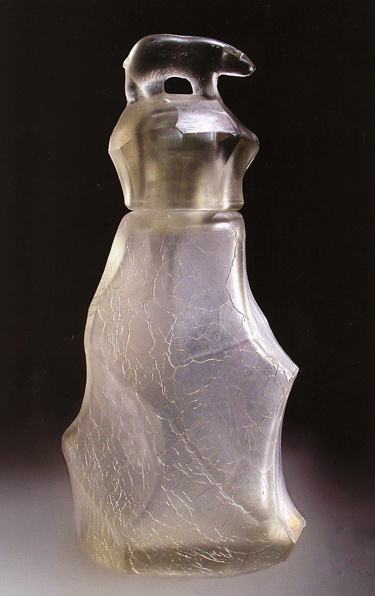
In 1908, even before the invention of Suprematism, Malevich developed the bottle design for the Severny cologne: nothing ideological, Malevich badly needed money, when he got this order. Perfume in such a container was produced from 1911 to the mid-90s: for 80 years, it was easy to complete the Malevich-inspired look.
Faceted glass
There is a legend holding that the famous faceted glass (in the form it existed in the USSR) was invented by Kazimir Malevich. He supposedly came up with it when he was imprisonned in Kresty on charges of espionage. An ordinary glass with thin walls burned his hands. Malevich invented a faceted glass, and when he emerged, he allegedly told the sculptor Vera Mukhina about this insight (another popular legend insists on her authorship). Well, if it is the case, it was a very far-sighted and effective move. This seemingly simple device helped the earthlings to maintain their contact with space for many years. They were more reliable than all paintings, philosophical works and Suprematist manifestos combined.This is how an ordinary knifegrinder looks like if seen through a faceted glass.
(Kazimir Malevich. The Knifegrinder, 1912)
Author: Andrii Zymohliadov






